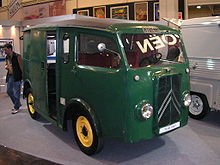Citroën type H
| Citroën | |
|---|---|
|
Citroën type H
|
|
| Citroën type H | |
| Manufacturer: | |
| Production period: | 1948-1981 |
| Previous model: | Citroën TUB |
| Successor: |
Citroën C25 Citroën C35 |
| Technical specifications | |
| Engines: | 4 cylinders
Petrol engines : |
| Length: | 4260 mm |
| Width: | 1990 mm |
| Height: | 2300 mm |
| Wheelbase: | 2443 mm |
The Citroën Type H was a van from the French car manufacturer Citroën , which replaced the Citroën TUB and the Citroën Type 32 . Depending on the permissible payload, different type designations were used (H, HY, HX, HW, HZ and 1600). HY is often used to denote all H models.
The type H was one of the most widespread small vans in France, because it was built from June 1948 to December 1981 - that is, for 33 years, at times also in Belgium and the Netherlands . Its successor was the Citroën C25 produced by Sevel , which was also available as the Peugeot J5 and Fiat Ducato .
history
The front-wheel drive delivery van H was presented at the Paris Motor Show in autumn 1947 , one year before the 2CV .
It was developed from the Citroën TUB , which was only built in small numbers before the war (which is why it is still often called "Tub" in France ). The engine and transmission came from the Traction Avant sedan and later the DS , but installed in reverse - i.e. with the engine in front of the front axle and with the engine rotating in the opposite direction.
The self-supporting body, clad with corrugated sheet metal, and the space-saving chassis with double wishbones at the front, parallel swing arms at the rear and torsion bar suspension on both axles enabled a low loading sill. It was 35 cm above the floor.
Models
The later model names HX, HY, HW and HZ denoted the variants with different payloads. The various extensions of the wheelbase and rear overhang, which were not built by Citroën itself, but only by bodywork companies (French Carrossier such as Currus , Gruau , Heuliez or SAPA ) had the designations Modification A (40 centimeters overhang) to Modification F (1, 2 meter wheelbase extension and 60 centimeter overhang). There were roof heights with 10 centimeters (for ambulances ), 20 centimeters and 40 centimeters and each with ( avec capot) or without ( sans capot) an increase in the roof over the driver's cab .
From the factory there was only the delivery van with a length of 4.28 meters and as a chassis with a driver's cab. Type H variants found widespread use in the public service, such as for the police , fire brigade , post office and as an ambulance. The offer of coachbuilder was primarily aimed at medium-sized companies, with covered wagon (with double cabin ), car carriers , low-floor trucks , sales vehicles , minibuses , refrigerated trucks , motor homes , livestock trucks, hearses , rolling laboratories and more. There were also variants with the hydropneumatic suspension of the DS on the rear axle, most of which were ambulances made by the Dutch coachbuilder Akkermans .
literature
- Fabien Sabatès, Wouter Jansen: Le Type H Citroën. Massin Editeur, 180 pages, ISBN 2-7072-0194-4 (French)
- Ulrich Knaack: Short career. The Transporter H in Germany. In: Knaack, Schrader (ed.): Citroën-Jahrbuch N ° 1 (2005). FGV-Verlag, Hannover 2004, ISBN 3-00-013667-3 , pp. 50-63




